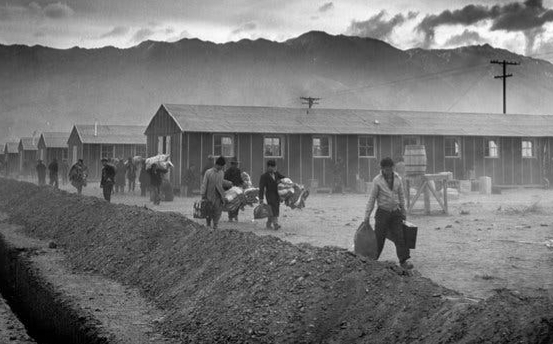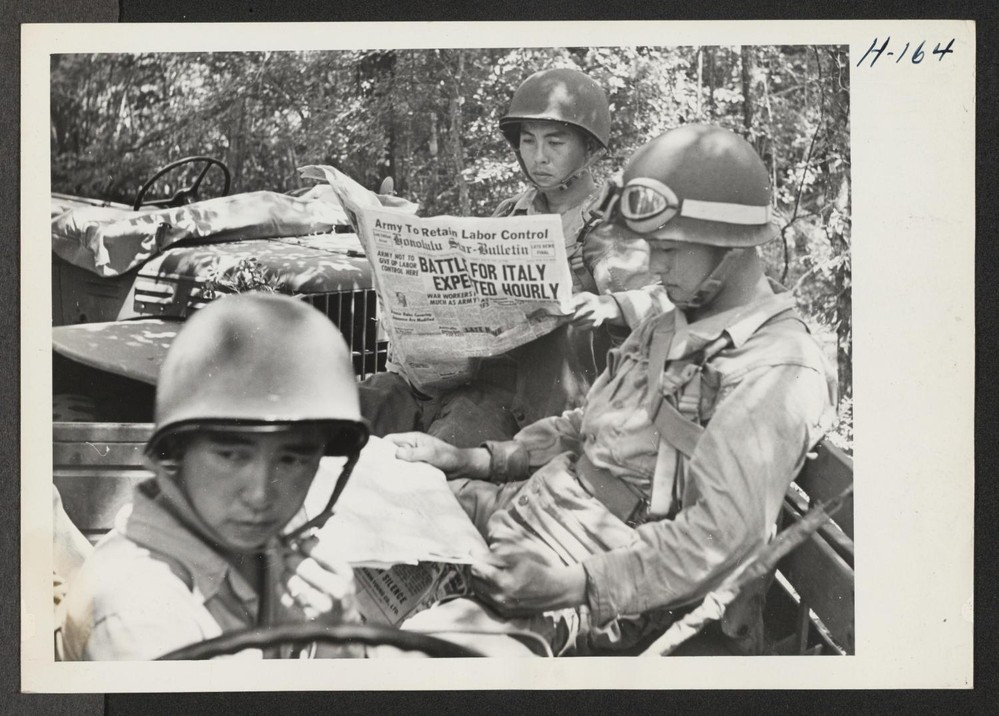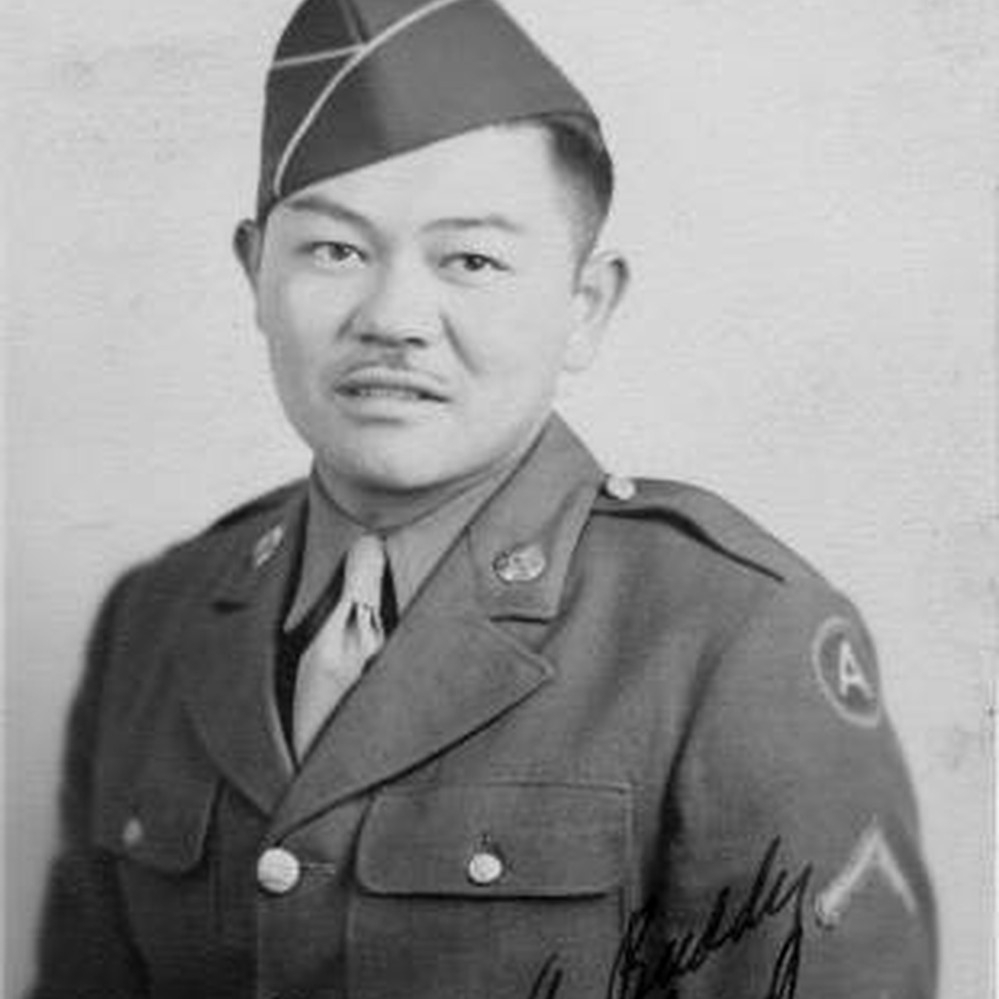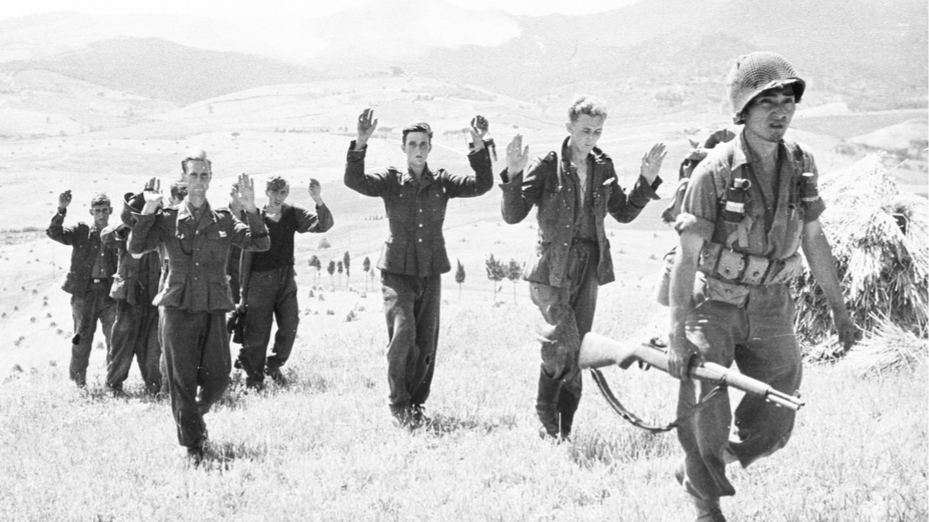Immigration: 4. Japanese
This is the Story of the 442nd US Infantry Regiment:
“The most decorated unit in United States military history for its size and length of service.”
4,000+ Purple Hearts
21 Medals of Honor
29 Distinguished Service Crosses
588 Silver Stars
4,000+ Bronze Stars
[U. S. Department of Defense Website]
The story begins with Pearl Harbor on December 7th, 1941. The attack on the U.S. Naval Base cost the lives of over 2,000 young American men. The American public was rightly outraged by the attack, however, many turned that frustration inwards and attacked the Americans of Japanese heritage in their own country. These Americans were discriminated, victimized and alienated. Treated with fear and aggression, people called them “Japs” and told them to “Go Back.”
“Monday, December 8, I told my father, three of my classmates and myself were going to Long Beach to enlist. He said, "That's good. You're an American. You should go with your friends." My classmates that I've been playing football with for 3 or 4 years, they're all Caucasian, they were taken in right away. And then they got to me they said, "You're a Jap. We don't want Japs in our Navy. Get the hell out of here." My classmates said, "The hell with the Navy, if they don't want you, we're not going either." We all left.” [Interview with Lawson Sakai, Hawaiian News]Americans of Japanese heritage had been given a Draft Classification of 4C – Enemy Alien – Unfit for Military Duty
Executive Order 9066
With mounting distrust of Americans with Japanese heritage, Franklin Roosevelt signed a Presidential Executive Order that stripped them of their civil rights. Families were removed from their homes, taking with them only what they could carry and transported to “Relocation Centers” commonly referred to as Internment camps.
"I looked at Santa Clara's streets from the train... I thought this might be the last look at my loved home city. My heart almost broke, and suddenly hot tears just came pouring out." - Norman Mineta, (House Representative for California 1975-1995)
Internment Camps
At the “Relocation Centers”, men, women and children were registered and given numbers. They found themselves surrounded by rifles and bayonets. Most of the camps were in the remote desert. They looked around them and saw hundreds of miles of wasteland. The barracks were lined in orderly rows surrounded by barbed-wire fences with guard towers. Every morning at seven the internees were awakened by a siren blast. The children went to school where they began the day by saluting the flag of the United States and singing "my country, tis of thee, sweet land of liberty." Looking beyond the flagpole, they saw the barbed wire, watchtowers and armed guards that kept them inside.
"I was mad . I was very disappointed, it hurt me quite a bit because here I was a college graduate, I was a loyal American, I had never been to Japan, and for them to treat me like an enemy-alien was devastating," [US Army Website interview with Grant Ichikawa]
Japanese Propaganda
Propaganda from Japan latched onto these Internment Camps and the Japanese government presented the war in the Pacific as a race war.
In response, FDR was urged by his own Military Intelligence that, "Loyal Americans of Japanese descent should be permitted... to enlist in the Army and Navy. This matter is of great interest... Japanese propaganda... insists that this is a racial war. We can combat this effectively with counter propaganda only if our deeds permit us to tell the truth."
Reversal on Policy
In June 1942, the military assembled their first segregated battalion of Japanese Americans. (African-Americans had already been fighting in segregated units) Most of these men had joined from Hawaii, where ironically, despite being the very territory that was attacked, the Japanese were not interned into “Relocation Centers”. Americans of Japanese decent made up 5% of Hawaii’s population and the government was concerned what internment would do to the Hawaiian economy.
Meanwhile, within the Internment Camps of the mainland, young men were made to answer a questionnaire, assessing their loyalty to the nation. From behind barbed wire, thousands of men swore allegiance to the United States. They were allowed to enlist in the United States army directly from the Internment Camps and joined the Hawaiian-Japanese Americans in Oakland, California.
The 442nd US Infantry Regiment was founded and sent to basic training at Fort Shelby, Mississippi. A total of 33,000 Japanese-Americans enlisted in the Armed Forces. “We were initially labeled enemy-aliens and many of us volunteered to fight for the U.S. Army and we offered our lives to prove we are loyal American citizens," Grant Ichikawa said.
Much like the Jewish Germans of World War One, these alienated minorities enlisted in record numbers to prove their loyalty. “For Jews, it was particularly important because of this, you know pervasive myth of Jews as weak or unpatriotic, and so they… felt a particular urgency to prove their worth and battle and the best.” – Ralph Blumenthal
During basic training in Mississippi, the Japanese-Americans of the 442nd regiment bonded over their shared desire to prove their worth. They decided to make their motto, “Go For Broke”, a mantra that embodied their aspiration to risk everything in an all-out effort. “They had a mission: to win freedom for their families in internment camps and to prove their loyalty by distinguishing themselves in combat." – U.S. Army Col. Hiraoki Morita
The 442nd Regiment in Action
The United States Army didn’t trust the 442nd to fight in the Pacific theater of war. So instead they were deployed into Europe. They landed in Tuscany, Central Italy and fought their way north across the Apuan Alps. “All three companies went into action, boldly facing murderous fire from all types of weapons and tanks and at times fighting without artillery support. Doggedly the members… fought their way into the strongly defended positions. The stubborn desire of the men… with a numerically superior enemy and the rapidity with which they fought enabled the Infantry Battalion to destroy completely the right flank positions of a German army...” – U.S. Army Center of Military History
Daniel Inouye
Daniel Inouye was shot in the stomach from 40 yards away. Ignoring his wound, he proceeded with the attack and together with the unit, destroyed the first two machine gun nests. As his squad distracted the third machine gunner, the injured Inouye crawled toward the final bunker and came within 10 yards. As he prepared to toss a grenade within, a German soldier fired out a rifle grenade at Inouye, striking him in the right elbow. Although it failed to detonate, the blunt force of the grenade amputated most of his right arm at the elbow. The nature of the injury caused his arm muscles to involuntarily squeeze the grenade tightly, preventing his arm from going limp and dropping a live grenade at his feet. In terrible pain, under fire with minimal cover and staring at a live grenade "clenched in a fist that suddenly didn't belong to me anymore." Inouye shouted at his platoon to keep back, afraid that his severed fist would drop the grenade.
The German inside the bunker began reloading his rifle, Inouye pried the live hand grenade from his useless right hand with his left, and tossed it into the bunker, killing the German. Stumbling to his feet, Inouye continued forward, killing at least one more German before sustaining his fifth and final wound of the day in his left leg. Inouye fell unconscious, and awoke to see the worried men of his platoon hovering over him. His only comment before being carried away was to gruffly order them back to their positions, saying "Nobody called off the war!" By the end of the day, the ridge had fallen to American control. The remainder of Inouye's mutilated right arm was later amputated at a field hospital without proper anesthesia. [National Museum of the United States Army]
After the war, Daniel Inouye received the Medal of Honor and would go on to study law, serve as a member of the U.S. House of Representatives from Hawaii and eventually served as a United States Senator for almost 50 years! [National WWII Museum Article]
The Lost Battalion
After three months in Italy, the 442nd was transported across the Mediterranean and landed in Marseille, France. They were charged with liberating two French towns, Bruyeres and Biffontaine. The unit faced dense fog, mud, heavy rain, large trees, hills, and heavy enemy gunfire and artillery. After securing this region, the 442nd was ordered to attempt the rescue of the “Lost Battalion”, the Texas 1st Battalion which had become encircled by German forces.
After an order to “fix” bayonets, men rose, firing from the hip, advancing as one, led by their commanding officer. "We yelled our heads off and shot the head off everything that moved... We didn't care anymore.” – Ichigi Kashiwagi, Private First Class Trees exploded around them while they rushed up the steep slopes, lobbing hand grenades into dugouts. Finally the German defenses broke and the surviving Germans fled in disarray.
“Staff Sergeant Sasaoka was assigned as a machine gunner on the last tank of a task force during the execution of a daring thrust through enemy-held terrain… As the task force advanced over a mountain trail, the enemy opened fire from well dug-in positions on both sides of the trail. Although seriously wounded by the first burst of hostile fire, Sergeant Sasaoka, displaying a disdain for personal safety seldom surpassed, clung to his machine gun and directed a hail of bullets into the enemy positions in a last desperate attempt to prevent the other members of his platoon from being subjected to the lethal enemy crossfire. Finally, unable to hang on any longer due to his weakened condition, Sergeant Sasaoka fell from the lurching tank. His magnificent courage and devotion to duty were in large measure responsible for the successful accomplishment of his platoon's mission and for saving the lives of many of his comrades. Staff Sergeant Sasaoka's intrepid actions, personal bravery and zealous devotion to duty at the cost of his life, exemplify the highest traditions of the military forces of the United States...” [Original 1945 award]
Pushing the Germans Back
By 1945, the 442nd Regiment was pushing the German troops back through the Apennines Mountains of Northern Italy. They suffered grueling warfare, fighting their way through a seemingly endless amount of artillery shells. Sadao Munemori, Private First Class raced forward through gunfire toward two machine gun nests, where he successfully used grenades to take out both. As more grenades were lobbed from the enemy side, Munemori sought cover in a shell crater where two of his men were already taking refuge. An unexploded grenade hit Munemori’s helmet and rolled toward his comrades. In a split-second decision, Munemori dived for the grenade in an attempt to smother the blast with his body, sacrificing his own life to save the lives of his two comrades. Sadao Munemori was two weeks shy of his 23rd birthday.
Sadao Munemori’s family held his initial memorial service behind the barbed wire fences of their internment camp. However, in 1948, burial rights were held at a Buddhist temple in Los Angeles. At the ceremony, his mother was presented with a Medal of Honor, the first Japanese-American to win the nation’s highest honor. In addition, the troop ship, which brought the 422nd back from the war, was renamed USNS Private Sadao S. Munemori in his honor. [Department of Defense Article]
Liberating Dachau Concentration Camp
Near the end of the war, one of the Japanese-American Battalions pushed into Southern Germany itself. Scouts located a satellite camp of the infamous Dachau Concentration Camp. “I watched as one of the scouts used his carbine to shoot off the chain that held the prison gates shut. He said he just had to open the gates when he saw a couple of the 50 or so prisoners, sprawled on the ground, moving weakly. They weren’t dead, as he had thought. When the gates swung open, we got our first good look at the prisoners. Many of them were Jews. They were wearing black and white striped prison suits and round caps… It was cold and the snow was two feet deep in some places. There were no German guards. They had taken off before we reached the camp. The prisoners struggled to their feet after the gates were opened. They shuffled weakly out of the compound. They were like skeletons — all skin and bones.”- Ichiro Imamura, U.S. Technician Fourth Grade
Japanese-American soldiers were freeing prisoners from the Concentration Camps of Germany, while many of their families back home were held captive in the United States Internment Camps. They fought in defense of a Country, that held their mothers, wives and children behind barbed wire fences as threats to national security.
Word gets back to America
Reports of the sacrifices made by the Japanese-American 443nd made their way back to the United States. Time Magazine, July 31st, 1944 read: "From a cautious experiment, the army had received an unexpectedly rich reward; a group of senua oriental soliders, only one generation removed from a nation that was fighting frantically against the United States, was fighting just as fanatically for it."
When the American Troops were welcoming back to the United States, the 442nd Regiment marched down Pennsylvania Avenue in Washington, DC. They were met by President Harry Truman, who gave a brief speech, saying, "You fought the enemy abroad and you fought prejudice at home and you won,"
End of Japanese Internment
Japan surrendered to the United State on September 2nd, 1945 and by the end of the year the United States had closed the majority of the Japanese Internment Camps. The 1988 Civil Liberties Act authorized $1.6 billion in reparations to be paid to the detainees and their descendants. Ronald Reagan officially apologized for the incarceration on behalf of the U.S. Government.
"My fellow Americans, we gather here today to right a grave wrong… This action was taken without trial, without jury. It was based solely on race... Yes, the Nation was then at war, struggling for its survival, and it's not for us today to pass judgment upon those who may have made mistakes while engaged in that great struggle. Yet we must recognize that the internment of Japanese-Americans was just that: a mistake. For throughout the war, Japanese-Americans in the tens of thousands remained utterly loyal to the United States. Indeed, scores of Japanese-Americans volunteered for our Armed Forces, many stepping forward in the internment camps themselves. The 442nd Regimental Combat Team, made up entirely of Japanese-Americans, served with immense distinction to defend this nation, their nation. Yet back at home, the soldiers' families were being denied the very freedom for which so many of the soldiers themselves were laying down their lives... The legislation that I am about to sign provides for a restitution payment to each of the surviving Japanese-Americans of those who were relocated or detained. Yet no payment can make up for those lost years. So, what is most important in this bill has less to do with property than with honor. For here we admit a wrong; here we reaffirm our commitment as a nation to equal justice under the law." – Ronald Reagan, 1988
Legacy
The perseverance of these men should be remembered today. They fought tooth and nail for a nation that did not trust them. Fighting in an army that did not always respect them. Barred from military service at the start of the conflict, they went on to prove their loyalty. They desired to prove wrong those who discriminated them. “The sacrifices of our parents and the sacrifices of the men in the 442nd were our way of earning that freedom,” Staff Sergeant Fred Shisoki told Spokane’s KXLY 4 News in 2006. “The right to be called an American, not a hyphenated American and I guess that’s my message to everybody.”
Today, the Segregated United States 442nd Regiment of Japanese heritage is recognized as the most distinguished for its size and length of service. in United States military history. [National WW2 Museum]














Comments
Post a Comment